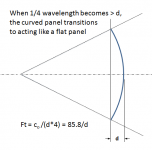Thank you for the simulation Bolserst. Just to recap',Since golfnut addressed your question in detail, I will only add that there is a spreadsheet posted for download that performs the calculations from the AES paper.
https://www.diyaudio.com/community/threads/experiences-with-esl-directivity.48120/post-5441902
The lower frequency extent of the segmentation is input parameter #6, fL. You will notice as you lower fL, the SPL of the whole response lowers.
The only thing missing is the calculation for frequency at which ka=1.
f(ka=1) = c/(width*pi) = 109.2/width, where width is in meters
Here is an example with parameters set for your 120dB line source.
View attachment 1052504
- So fL is the frequency in which the segmentation stops and the whole panel works as an un-segmented panel and the whole area of the membrane is active, correct?
- At a pre-determined max SPL, the reason for the ka=1 calculation above is to determine how wide the panel have to be to make sure that fL is at ka<1?
- How do you determine the arc dimensions?It results from the wavelength of sound relative to the width of the panel and the dimensions of the arc. The polar response necks down when the wavelength becomes large relative to the arc dimensions but still small relative to the width (ie panel starts to behave like it is flat not curved). Continuing to go down in frequency, once the wavelength becomes larger relative to the panel width the polar response reverts to the classic dipole.
- so 90-degree arc will have the neck lower in frequency range than 30-degree?
Yes- So fL is the frequency in which the segmentation stops and the whole panel works as an un-segmented panel and the whole area of the membrane is active, correct?
The panel width is chosen to achieve the desired max SPL down to a chosen frequency.- At a pre-determined max SPL, the reason for the ka=1 calculation above is to determine how wide the panel have to be to make sure that fL is at ka<1?
The ka=1 frequency for that panel width is a fallout of the desired max SPL.
The arc dimension is geometrically dependent on the panel width and extent of the arc in degrees.
- How do you determine the arc dimensions?
- so 90-degree arc will have the neck lower in frequency range than 30-degree?
Yes, 90deg arc will transition to acting like a flat panel at a lower frequency than a 30deg arc.

I see bolserst has already analysed this case in https://www.diyaudio.com/community/threads/if-you-had-a-lot-of-esl-panels.240162/post-3585604 et al... from #373 ...
128dB spl is simply 20 x log10(50N/m2) referred to 94dB (1 Pascal spl) and is at the diaphragm. This is the pressure exerted by the diaphragm so is also the spl over most of it.
For an arrangement like your #356 where the panels take up most of the room's x-section, you are nearly 'propagating' a Plane Wave into the room so the spl doesn't drop much with distance. Hence my comments about operating in the Near Field. Room effects apply but usually help rather than hinder spl in this case
You can envisage large full range panels (no segmentation bla bla) making up the walls of your room propagating 'Plane Waves' over the whole frequency range ... and this would some nice properties for stereo too
The stereo implications are in https://www.diyaudio.com/community/threads/if-you-had-a-lot-of-esl-panels.240162/post-3585011
But instead of messing about with delay lines, if you have enough full range panels to fill your room x-section, why not just have two sets of panels actually toed in?
You would still have to do something about what's behind the panels but the simplest solution is to simply have the 'tilted panel wall' 1/3 of the way from the 'back' wall. I've simulated with PAFEC and tried in practice, this arrangement with EML dipoles and this 'interlaces' the room modes very nicely indeed. I don't know what this would be like with 'pressure' transducers like large ESL panels which react to 'room loading' differently.
The work was done for an active dipole speaker system, Option 1, optimised for stereo in a 'large' space.
Steve, are your 'directivity' plots done with a FEA/BEA package? If so, could you simulate large full range ESL panels like this in one of your real Texan living rooms to see what the response & spl is like in a 'listening area' ... ie is everyone in the 'near field' ? The room modes are very dominant here.